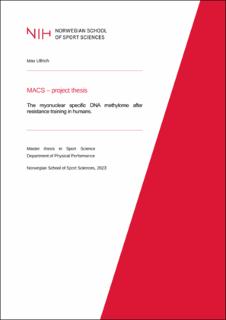| dc.description.abstract | Background: Resistance training (RT) is known to induce significant adaptations in skeletal muscle, but the underlying molecular mechanisms driving these adaptations, particularly the role of epigenetic changes, remains incomplete. Using Magnetically Activated Cell Sorting (MACS) with the myonuclei specific marker Pericentriolar material 1 (PCM1), we provide the first cell population specific epigenomic information in human skeletal muscle before and after adaptation to RT.
Methods: Nine previously strength un-trained participants underwent 7 weeks of supervised progressive high volume resistance training. Genomic DNA was isolated from MACS purified myonuclei (MYO) and from all nuclei within whole skeletal muscle tissue that included myonuclei and interstitial nuclei (MYO+INT) from the vastus lateralis of the non-dominant leg before (baseline) and after (post) the intervention. Using Illumina EPIC arrays, we compared the effect of RT on the methylome of MYO vs. MYO+INT.
Results: All participants significantly increased their lean mass by 6.0±2.6% equaling 3.3±1.5kg (p<0.0005) following RT. A total of 223,352 differentially methylated probes (DMPs) in untrained muscle, and 232,035 DMPs in trained muscle were identified in the MYO vs. MYO+INT cell nuclei populations (FDR < 0.05). Additionally, post vs. baseline comparison identified 27,599 DMPs in MYO and 20,543 DMPs in MYO+INT cell populations following RT (p<0.05). Only 1.9%/901 DMPs overlapped between MYO and MYO+INT cell nuclei populations following RT, of which only 548 DMPs observed the same directionality of differential methylation. Although both cell populations were hypomethylated across all DMPs following RT, when focusing specifically on DMPs located in CpG islands within gene promoter regions, the MYO cell population had a predominantly hypermethylated profile post RT (70.7%/1,789 DMPs hypermethylated) while MYO+INT had a predominantly hypomethylated profile following RT (54.7%/1,032 DMPs hypomethylated). Utilizing over-representation analysis (ORA) we identified 39 significant pathways in MYO+INT and 52 significant pathways in MYO (p < 0.05), with 14 pathways significantly over-represented in both cell nuclei populations following RT. Six of the shared pathways (Lysine degradation, Cell cycle, Oxytocin signaling pathway, Endocrine and other factor-regulated calcium reabsorption, and Carbohydrate digestion and absorption) observed opposite directionality of differential methylation following RT. Interestingly, the canonical Wnt/β-catenin signaling pathwayobserved a hypomethylation in MYO+INT and hypermethylation in MYO cell populations following RT, indicating a differential role for Wnt pathway genes in human myonuclei and interstitial cells. Additionally, ORA identified over-representation of Leukocyte transendothelial migration as well as fibroadipogenic progenitor- and endothelial cell specific gene sets exclusively in the MYO+INT cell population.
Conclusion: Taken together, these data suggest differential methylation consistent with cell population specific adaptations to RT. Additionally, the present study highlights that interpretation of whole skeletal muscle tissue methylation profiles should begin to take account of cell nuclei specific alterations and that the differences between myonuclear and interstitial DNA methylation profiles resulting from varying myonuclear and interstitial cell proportions should be considered. | en_US |
